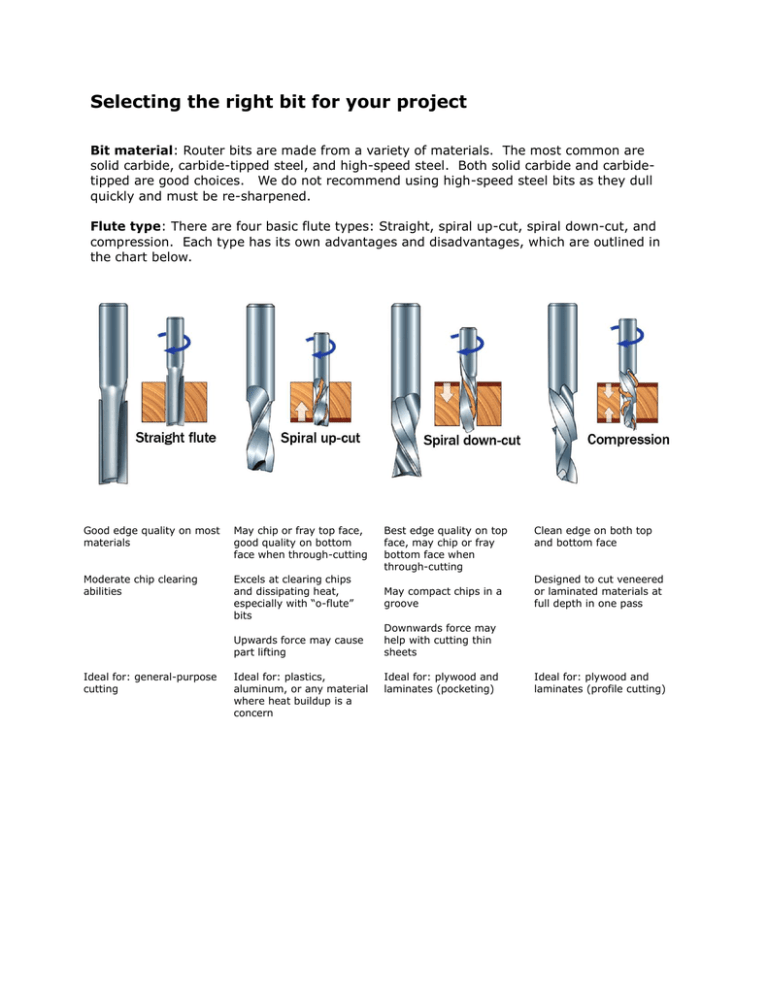Selecting the right bit for your project
advertisement

Selecting the right bit for your project Bit material: Router bits are made from a variety of materials. The most common are solid carbide, carbide-tipped steel, and high-speed steel. Both solid carbide and carbidetipped are good choices. We do not recommend using high-speed steel bits as they dull quickly and must be re-sharpened. Flute type: There are four basic flute types: Straight, spiral up-cut, spiral down-cut, and compression. Each type has its own advantages and disadvantages, which are outlined in the chart below. Good edge quality on most materials May chip or fray top face, good quality on bottom face when through-cutting Moderate chip clearing abilities Excels at clearing chips and dissipating heat, especially with “o-flute” bits Upwards force may cause part lifting Ideal for: general-purpose cutting Ideal for: plastics, aluminum, or any material where heat buildup is a concern Best edge quality on top face, may chip or fray bottom face when through-cutting May compact chips in a groove Clean edge on both top and bottom face Designed to cut veneered or laminated materials at full depth in one pass Downwards force may help with cutting thin sheets Ideal for: plywood and laminates (pocketing) Ideal for: plywood and laminates (profile cutting) What’s the difference between a square-end bit and an end mill? An end mill has cutting flutes that extend across the bottom (end) of the bit. It is designed for plungecutting as well as lateral cutting. “Square-end” is simply a description of end shape. Square-end bits are not always end mills, and end mills do not always have square ends. The first image below shows a true end mill, and the second shows a straight-fluted, square-end bit that is not an end mill. A ramp-in must be applied to a toolpath when using this type of bit. Number of flutes: The number of flutes on a bit is essential to calculating proper feed and speed rates. For most applications you can use a bit with 1, 2, or 3 flutes, but you must adjust your reed rates and RPM accordingly to maintain proper chip load. End shape: Straight and up-spiral bits come in a variety of end shapes. Square ends are most common, and are a good choice for creating pockets and grooves, profile cutting, simple lettering, and drilling operations. Ball (or rounded) ends are best for 3D carving. V-carve bits are often used to create complex letters for sign making. They can also be used to chamfer edges and create countersinks for screw holes. Calculating feeds/speed with Chip Load: Chip load refers to the actual thickness of the chip cut by each revolution of the cutter. It is the measurement that all feed/speed calculations are based on. A spinning bit generates friction and heat as it moves through the material, and part of this heat is pulled away by the flying chips. A larger chip load pulls away more heat, but also puts more stress on the cutter. Each material has its own ideal chip load range that balances heat dissipation with cutter stress. A basic chart for common materials is available in the SB3 software. Click on Tools > Chip Load Calculator, then click on Chip Load Help. You can use this chart along with the Chip Load Calculator to determine a good starting speed for each toolpath. More detailed chip load charts are available online at Onsrud’s website (www.onsrud.com). When calculating feeds/speeds for a toolpath, do not rely on the defaults in your tool database. Those values are only placeholders and are not intended for any particular material.



